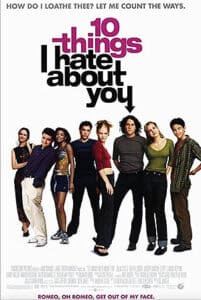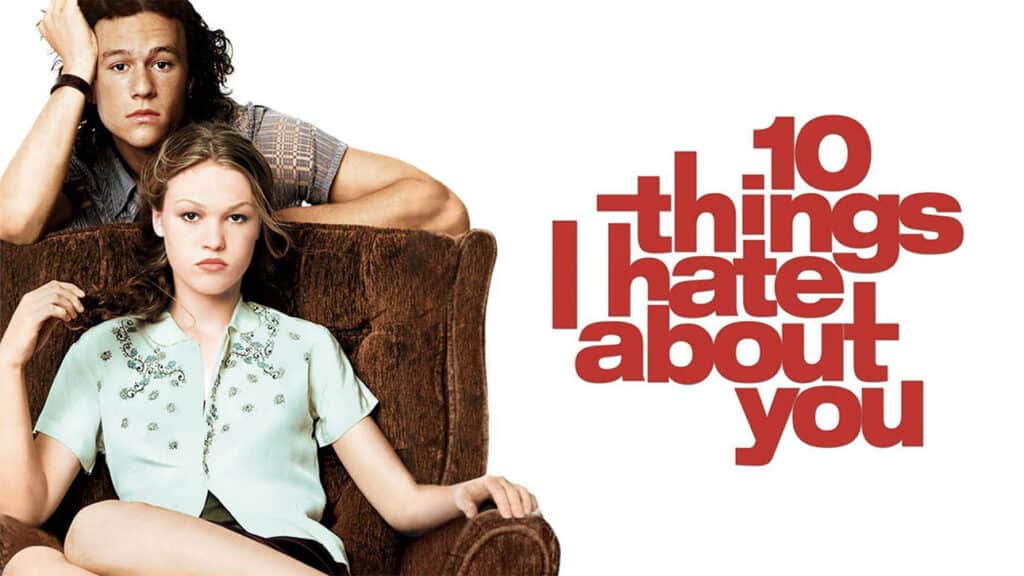
Out of its many failed cultural promises, the mid to late 1990s did deliver on something: film adaptations of classic literature aimed at the adolescent market, such as Amy Heckerling’s 1995 feature film debut Clueless, a modern take on Jane Austen’s Emma. Amanda Bynes would later dress in boy drag for a modern adaptation of Shakespeare’s Twelfth Night in the 2000s, but it was only made possible by Gil Junger’s teenage alteration of The Taming of the Shrew, released as 10 Things I Hate About You in 1999. Now, 25 years later, it’s still one of the best teen comedy films ever made.
If you can’t immediately recall the plot of Shakespeare’s The Taming of the Shrew, that might be a good thing. Indeed, the 16th-century production reads today as incredibly sexist and misogynistic, in which a male hero, as the title suggests, tames a “shrew” of a woman into someone desirable to society. But 10 Things I Hate About You screenwriters Karen McCullah and Kirsten Smith knew how to use this to their advantage.
The modern retelling of the Shakespeare play transports us to Padua High School in suburban Seattle, where young Cameron James (Joseph Gordon Levitt) has just transferred. He nearly immediately sets his romantic sights on Bianca Stratford (Larisa Oleynik), but she’s the one girl none of the boys can have. Her overprotective obstetrician father Walter (Larry Miller) has forbade his daughters from dating. But Bianca’s eagerness to pursue the predatory glances of their school’s resident bad boy Joey (Andrew Keegan) results in an alteration of the rules: Bianca can date, as soon as her older sister does.
This sounds easy enough if Bianca’s sister didn’t happen to be Kat Stratford (Julia Stiles), described by the effervescent guidance counselor as the school’s resident “heinous bitch”. Kat finds this descriptor amusing since she doesn’t care what people think. This is evident from 10 Things I Hate About You‘s opening scene, where several stereotypical teenage girls in a late ‘90s car pull up to a stoplight, bopping along to a Top 40 radio offering. Pulling up beside them is Kat, driving a rundown second-hand vehicle while blasting Joan Jett’s “Bad Reputation“.
Like Jett, Kat truly doesn’t give a damn about her reputation. She tears down freshly printed posters advertising the prom, refers to her fellow students as unwashed miscreants, and routinely speaks her mind in class. Indeed, she pegs Ernest Hemingway for the “abusive, alcoholic misogynist” he was, who “squandered half of his life hanging around Picasso trying to nail his leftovers.”
She boldly demands why their English classes can never assign books by feminist trailblazers like Sylvia Plath, Simone de Beauvoir, or Charlotte Bronte. But the film’s screenplay is always in on the irony, as their Black teacher will always check Kat’s white privilege: “Kat, I want to thank you for your point of view. I know how difficult it must be for you to overcome all those years of upper-middle-class suburban oppression. Must be tough. But the next time you storm the PTA, crusading for better lunch meat, or whatever it is you white girls complain about, ask them why they can’t buy a book written by a Black man.”
Ultimately, 10 Things I Hate About You establishes its strong point of view through that of Kat, a character very clearly influenced by the Riot-Grrrl movement of her era. Given that the film is set in Seattle and the underground feminist movement of the ’90s began in Olympia, Washington, it’s a clever connection, albeit not one that the audience might immediately be privy to. Where older teenagers and young adults might have been familiar with the Riot Grrrl movement and its association with anti-grunge music, younger viewers at the time of the film’s release would have likely been unaware – at least until they met Kat Stratford.
Kat’s angry girl image defines her character not only in the context of the film but also in the lexicon of teen entertainment as a whole. In 1999, the feminine ideal was portrayed by the mainstream as the sexualized innocence of Britney Spears and Christina Aguilera. It was not the intensely anti-capitalist, politically aware, if somewhat jaded façade of Kat Stratford in 10 Things I Hate About You.
Gen Z’s teenagers and young adults are much more politically informed because they’ve had to be. But a quarter century ago, it was radical for an intensely feminist, angry female character to be at the forefront of a seemingly conventional teen comedy film The Walt Disney Company released. “Expressing my opinion is not a terrorist action,” Kat tells Ms. Perky (Allison Janney).
In an elaborate attempt to gain Bianca’s affection, Cameron and his friend Michael (David Krumholtz) craft a plan to entice Joey into paying someone to take out Kat so that Joey can date Bianca per their father’s rule. They settle on a character so textually Shakespearean, Patrick Verona (Heath Ledger), a burnout and an outcast of whom most students are afraid. Against all odds, he commits to Joey’s paid proposal to date Kat. The problem, of course, is that on the surface, Patrick is everything that Kat is not.
As the ruse goes on, Patrick and Kat become more entwined and enamored with each other. But in a clear departure from the Shakespearean source material, there is no taming of this shrew. If anything, it’s Patrick who realizes he needs to better himself to make himself worthy of Kat’s affection. He quits smoking and tries to acclimate himself to more of Kat’s interests, aptly described as “Thai food, feminist prose, and angry girl music of the indie rock persuasion.”
When Kat is among those who truly understand her, like at a Letters to Cleo concert, she can let her guard down and be herself. To let Patrick into this inner sphere is significant for her. After all, Kat is not an outcast at school because of rumor mills or schoolyard bullying. She is a self-identified pariah because she’s learned the way of the world early on, maybe even earlier than she should have.
In addition to her mother abandoning the family, she figured out that, in this society, “being male and an asshole makes you worthy of our time” and that societal expectations aren’t to be followed. “Why should I live up to other people’s expectations instead of my own?” Kat doesn’t even let her father guilt her into going to college closer to home so that he might continue to restrain her. “I want you to trust me to make my own choices, and I want you to stop trying to control my life just because you can’t control yours,” she tells him.
Even Kat’s sense of fashion is tightly wound with her angry feminist image, dressing in more masculine-looking clothing so that she might not be stereotyped. There is even evidence to suggest that her musical taste that of the Riot Grrrl movement has educated and informed her of the violence against women in the world. As The New York Times reported in 2019, Riot Grrrl bands such as Bratmobile, the Raincoats, and Bikini Kill are credited as bringing awareness to the social issues they addressed through music, such as patriarchy, classism, rape culture, domestic violence, and female empowerment. In a world before social media, Kat Stratford was radicalized by music—the epitome of the ’90s.
To invite someone to share romantic space in this radicalized sense of self that Kat has developed and maintained is monumental, so when Patrick declines to kiss her back because she’s drunk after a house party, she is understandably miffed. Although Heath Ledger as Patrick emulates a chauvinistic tough-guy image who would never pander to a girl’s feelings, the screenplay once again proves expectations wrong. In order to get back into Kat’s good graces, he ropes the school’s marching band to accompany him in a vocal performance of Frankie Valli’s “Can’t Take My Eyes Off of You” in front of most of the school.
Kat’s angry image is never tamed as it would have been by a Shakespearean rulebook. Instead, Patrick – inspired by Kat’s strength in her own personhood – learns to improve himself. So when Kat learns of his initial motives for dating her at the senior prom, it would have been very easy for her to return to her annoyed, cynical persona forever.
But Kat has fallen hard, evidenced by 10 Things I Hate About You’s famous penultimate scene when she shares her Shakespearean poetry assignment with her English class. “I hate it when you lie, I hate it when you make me laugh, even worse when you make me cry. I hate it when you’re not around and the fact that you didn’t call. But mostly, I hate the way I don’t hate you, not even close, not even a little bit, not even at all.”
Additionally, in a clear departure from her androgynous fashion sense throughout most of the film, Kat is seen in a flowy white blouse and her hair down in a French braid, suggesting she’s finally willing to let her emotional guard down and reveal another side of herself. Rather than having her icy, angry exterior melt away for a boy, Kat’s tearful narration of her poem signals that she’s learning how to allow herself to be soft and vulnerable and learning that there’s no weakness in that.
But what makes 10 Things I Hate About You the most radical teen film – and the most endearing for the generations to come – is that the female main character never has to sacrifice who she is for a love interest. Not even a little bit, not even at all. This suggested to young female viewers of the time that being an angry woman need not be a bad thing and that you don’t have to compromise your morals and beliefs to find love. Kat Stratford could never be conceived as a shrew because her supposedly negative traits were her strengths all along. That’s an empowering message for teenage girls today.


![Call for Papers: All Things Reconsidered [MUSIC] May-August 2024](https://www.popmatters.com/wp-content/uploads/2024/04/all-things-reconsidered-call-music-may-2024-720x380.jpg)



